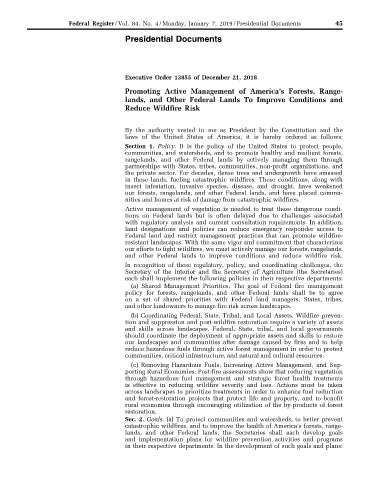Page 763 - Trump Executive Orders 2017-2021
P. 763
Federal Register / Vol. 84, No. 4 / Monday, January 7, 2019 / Presidential Documents 45
Presidential Documents
Executive Order 13855 of December 21, 2018
Promoting Active Management of America’s Forests, Range-
lands, and Other Federal Lands To Improve Conditions and
Reduce Wildfire Risk
By the authority vested in me as President by the Constitution and the
laws of the United States of America, it is hereby ordered as follows:
Section 1. Policy. It is the policy of the United States to protect people,
communities, and watersheds, and to promote healthy and resilient forests,
rangelands, and other Federal lands by actively managing them through
partnerships with States, tribes, communities, non-profit organizations, and
the private sector. For decades, dense trees and undergrowth have amassed
in these lands, fueling catastrophic wildfires. These conditions, along with
insect infestation, invasive species, disease, and drought, have weakened
our forests, rangelands, and other Federal lands, and have placed commu-
nities and homes at risk of damage from catastrophic wildfires.
Active management of vegetation is needed to treat these dangerous condi-
tions on Federal lands but is often delayed due to challenges associated
with regulatory analysis and current consultation requirements. In addition,
land designations and policies can reduce emergency responder access to
Federal land and restrict management practices that can promote wildfire-
resistant landscapes. With the same vigor and commitment that characterizes
our efforts to fight wildfires, we must actively manage our forests, rangelands,
and other Federal lands to improve conditions and reduce wildfire risk.
In recognition of these regulatory, policy, and coordinating challenges, the
Secretary of the Interior and the Secretary of Agriculture (the Secretaries)
each shall implement the following policies in their respective departments:
(a) Shared Management Priorities. The goal of Federal fire management
policy for forests, rangelands, and other Federal lands shall be to agree
on a set of shared priorities with Federal land managers, States, tribes,
and other landowners to manage fire risk across landscapes.
(b) Coordinating Federal, State, Tribal, and Local Assets. Wildfire preven-
tion and suppression and post-wildfire restoration require a variety of assets
and skills across landscapes. Federal, State, tribal, and local governments
should coordinate the deployment of appropriate assets and skills to restore
our landscapes and communities after damage caused by fires and to help
reduce hazardous fuels through active forest management in order to protect
communities, critical infrastructure, and natural and cultural resources.
(c) Removing Hazardous Fuels, Increasing Active Management, and Sup-
porting Rural Economies. Post-fire assessments show that reducing vegetation
through hazardous fuel management and strategic forest health treatments
is effective in reducing wildfire severity and loss. Actions must be taken
across landscapes to prioritize treatments in order to enhance fuel reduction
and forest-restoration projects that protect life and property, and to benefit
khammond on DSK30JT082PROD with PRESDOC2 VerDate Sep<11>2014 16:01 Jan 04, 2019 Jkt 247001 PO 00000 Frm 00001 Fmt 4790 Sfmt 4790 E:\FR\FM\07JAE0.SGM 07JAE0
rural economies through encouraging utilization of the by-products of forest
restoration.
Sec. 2. Goals. (a) To protect communities and watersheds, to better prevent
catastrophic wildfires, and to improve the health of America’s forests, range-
lands, and other Federal lands, the Secretaries shall each develop goals
and implementation plans for wildfire prevention activities and programs
in their respective departments. In the development of such goals and plans:

